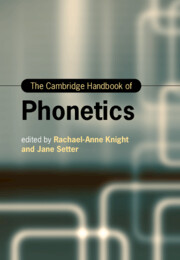Book contents
- The Cambridge Handbook of Phonetics
- Cambridge Handbooks in Language and Linguistics
- The Cambridge Handbook of Phonetics
- Copyright page
- Contents
- Figures
- Tables
- Contributors
- Introduction
- Section I Segmental Production
- Section II Prosodic Production
- Section III Measuring Speech
- Section IV Audition and Perception
- Section V Applications of Phonetics
- 20 Pedagogical Approaches
- 21 Pronunciation Teaching
- 22 Sociophonetics
- 23 Developmental Phonetics of Speech Production
- 24 Clinical Phonetics
- 25 Forensic Phonetics
- 26 The Phonetics of Talk in Interaction
- 27 The Phonetics/Phonology Interface
- Index
- References
26 - The Phonetics of Talk in Interaction
from Section V - Applications of Phonetics
Published online by Cambridge University Press: 11 November 2021
- The Cambridge Handbook of Phonetics
- Cambridge Handbooks in Language and Linguistics
- The Cambridge Handbook of Phonetics
- Copyright page
- Contents
- Figures
- Tables
- Contributors
- Introduction
- Section I Segmental Production
- Section II Prosodic Production
- Section III Measuring Speech
- Section IV Audition and Perception
- Section V Applications of Phonetics
- 20 Pedagogical Approaches
- 21 Pronunciation Teaching
- 22 Sociophonetics
- 23 Developmental Phonetics of Speech Production
- 24 Clinical Phonetics
- 25 Forensic Phonetics
- 26 The Phonetics of Talk in Interaction
- 27 The Phonetics/Phonology Interface
- Index
- References
Summary
The most natural environment for both speaking and learning to speak is face-to-face interaction. This chapter explores some of the ways in which the demands of this ecology shape the phonetic design of turns-at-talk, focusing on how social actions are accomplished through talk, the methods of Conversation Analysis, the structure of turns at talk, and their organisation into sequences of action, and how affective and epistemic displays are made audible.
- Type
- Chapter
- Information
- The Cambridge Handbook of Phonetics , pp. 657 - 681Publisher: Cambridge University PressPrint publication year: 2021
References
26.7 References
- 2
- Cited by



